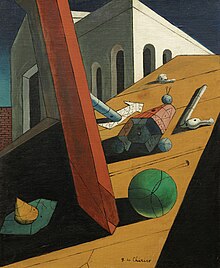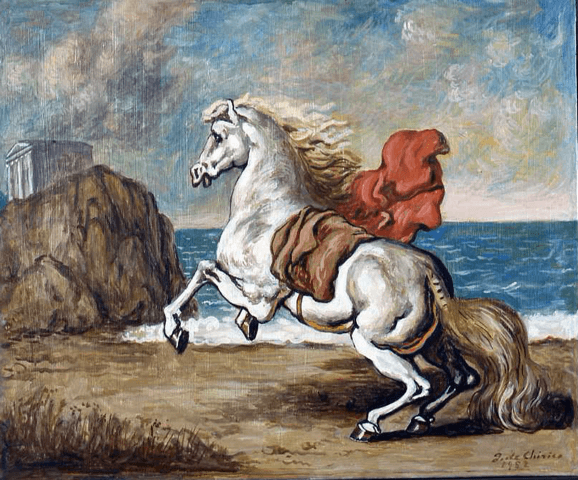De
Chirico strongly influenced the Surrealist movement:
Yves Tanguy wrote
how one day in 1922 he saw one of de Chirico's paintings in an art dealer's
window, and was so impressed by it he resolved on the spot to become an
artist—although he had never even held a brush. Other Surrealists who
acknowledged de Chirico's influence include Max Ernst, Salvador Dalí,
and René Magritte,
who described his first sighting of de Chirico's The Song of Love [below] as
"one of the most moving moments of my life: my eyes saw thought
for the first time."*
In
November 1919, de Chirico published an article in Valori
plastici entitled
"The Return of Craftsmanship", in which he advocated a return to traditional
methods and iconography.[18] This
article heralded an abrupt change in his artistic orientation, as he adopted a
classicizing manner inspired by such old masters as Raphael and Signorelli,
and became part of the post-war return to order in
the arts. He became an outspoken opponent
of modern
art.
In
the early 1920s, the Surrealist writer André
Breton discovered one of de Chirico's metaphysical paintings on
display in Guillaume's Paris gallery, and was enthralled.[20] Numerous
young artists who were similarly affected by de Chirico's imagery became the
core of the Paris Surrealist group centered around Breton. In 1924 de Chirico
visited Paris and was accepted into the group, although the surrealists
were severely critical of his post-metaphysical work.[21]
... His
relationship with the Surrealists grew increasingly contentious, as they
publicly disparaged his new work; by 1926 he had come to regard them as
"cretinous and hostile."[23] They
soon parted ways in acrimony.
...
The
Evil Genius of a King:
De
Chirico's later paintings [below] never received the same critical praise as did
those from his metaphysical period. He resented this, as he thought his later
work was better and more mature. He nevertheless produced backdated
"self-forgeries" both to profit from his earlier success, and as an act of
revenge—retribution for the critical preference for his early work.[24] He
also denounced many paintings attributed to him in public and private
collections as forgeries**.
1952
piece:
*Also
during 1922, the poet Marcel Lecomte showed
Magritte a reproduction of Giorgio de
Chirico's The Song of
Love (painted
in 1914). The work brought Magritte to tears; he described this
as "one of the most moving moments of my life: my eyes saw thought
for the first time."
**During
1947–48, Magritte's "Vache period," he painted in a provocative and
crude Fauve style.
During this time, Magritte supported himself through the production of
fake Picassos, Braques,
and de Chiricos—a fraudulent repertoire he was later to expand
into the printing of forged banknotes during the lean postwar period. This
venture was undertaken alongside his brother Paul and fellow Surrealist and
"surrogate son" Marcel Mariën,
to whom had fallen the task of selling the forgeries.[13] At
the end of 1948, Magritte returned to the style and themes of his pre-war
surrealistic art.
McCartney
owned/owns some Magritte's.





Comments
Post a Comment